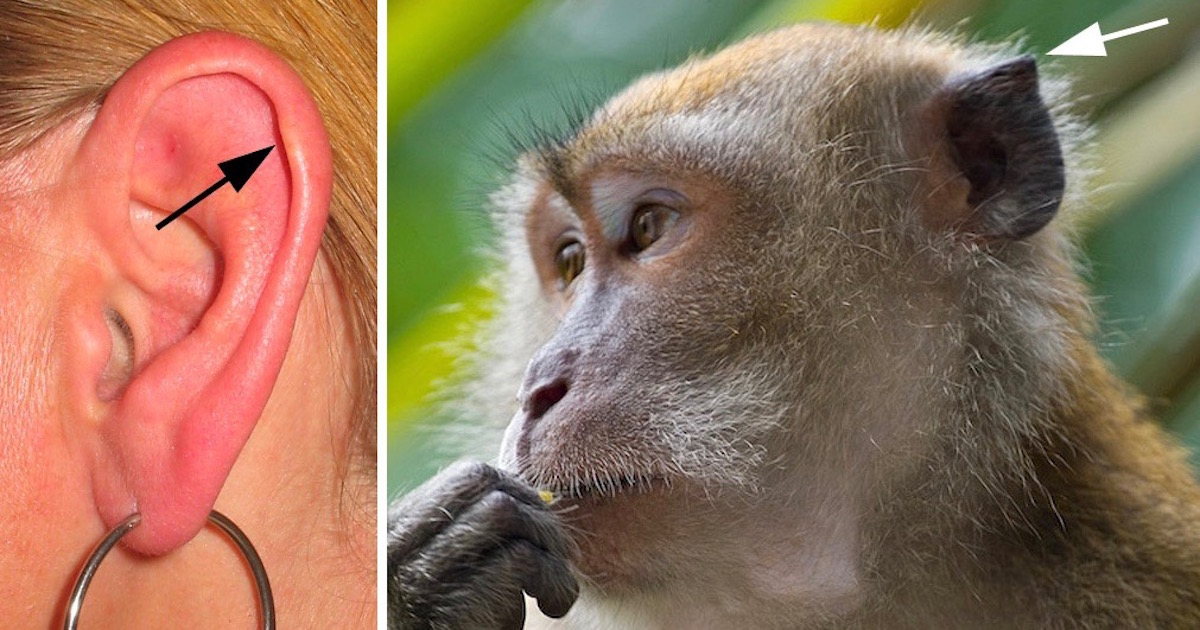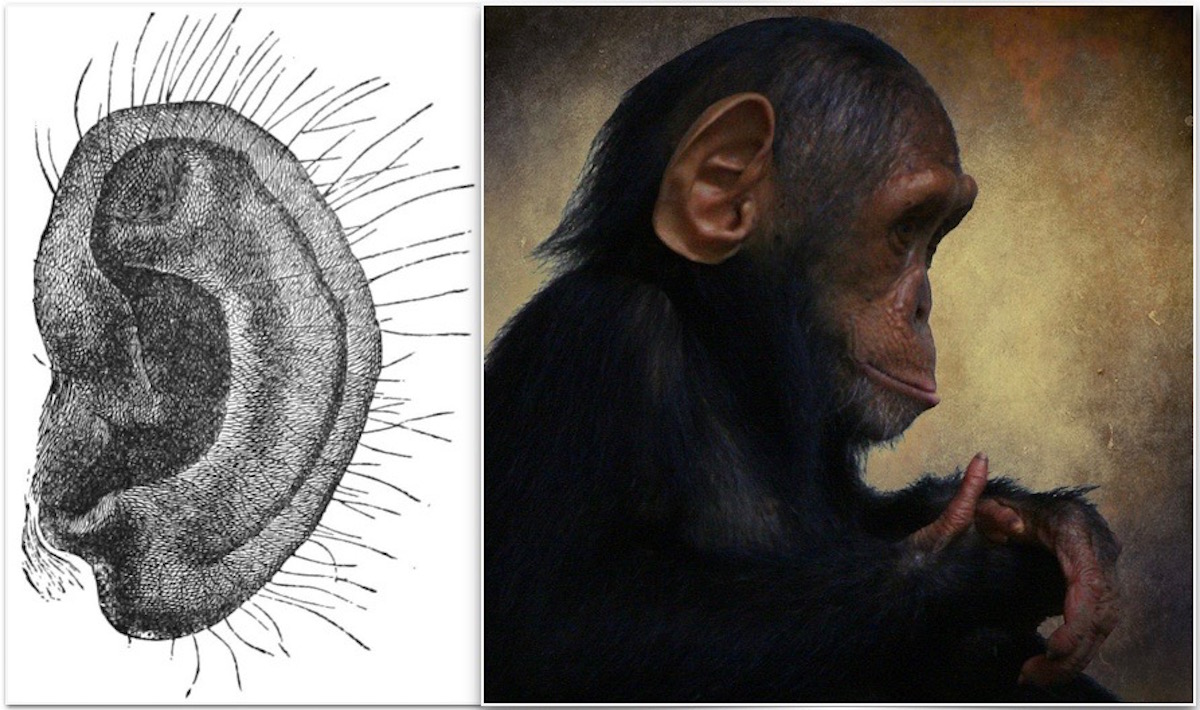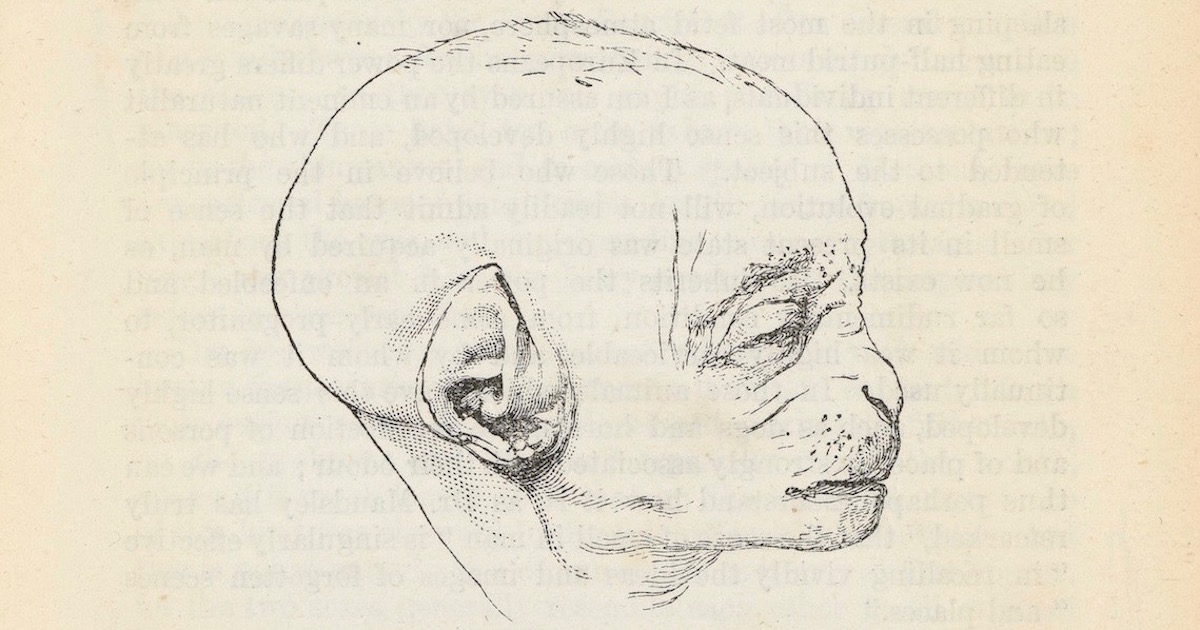 Evolution
Evolution
 Human Origins
Human Origins
Darwin’s Point: No Evidence for Common Ancestry of Humans with Monkeys


In a recent post for Evolution News, we discussed vestigial structures as alleged evidence for evolution (Chaffee 2017). As an illustration, the article featured an image of the auricular tubercles or “Darwin’s ear points,” a bump-like thickening on the helix of the auricle (exterior ear) of many people that is often claimed to be an atavistic vestige of the pointy ear tip found in monkeys. Evolutionists say the feature proves a shared ancestry of humans with lower primates.
The bump was originally discovered by the celebrated British sculptor Thomas Woolner, who informed Charles Darwin about it. In The Descent of Man, Darwin (1871:15-17) cited this structure as probable evidence for common ancestry of humans and monkeys. However, at the same time there were already published doubts about this interpretation (Meyer 1871), mainly because of the variability in humans.
Nevertheless, the claim that Darwin’s tubercle is an atavistic structure is still often heard today. Martin Nickels (1998), an anthropologist at Illinois State University, presented Darwin’s tubercle among his “Twelve Lines of Evidence for the Evolution of Humans & Other Primates,” which was featured at the Talk Origins website and published in the 1998 Creation-Evolution issue of the Reports of the National Center for Science Education. In the Wikipedia articles on “Vestigiality” and “Human Vestigiality,” the tubercle is mentioned as one example of vestigial structures. Many popular blogs list this feature as strong evidence for human evolution. Here are two examples:
In “WEIT: Human Vestigiality & Atavisms” (March 19, 2011), on the atheist blog Reflections from the Other Side: Leaving Christianity and Embracing Skepticism, the author refers to Jerry Coyne’s book Why Evolution Is True:
I want to add one atavistic feature that Coyne doesn’t mention: a tiny, almost imperceptible point on the outer rim of the ear known as Darwin’s tubercle. Only 10% of the population has it, but I’m lucky enough to be part of that statistic. Darwin’s tubercle demonstrates our common ancestry with other primates, which have significantly more prominent pointed ears, possibly to help funnel sound into the auditory canal. Below is my ear, a macaque’s ear and an example illustration from Darwin’s The Descent of Man.
It’s both startling and fascinating to realize that I carry tangible, visible evidence for evolution with me wherever I go. And by no means is this connection to the past is something to be ashamed of. On the contrary, to bear such tokens of our history just serves as a reminder of how far our species has come.
In “I Have Primitive Ears” (April 28, 2012), on the blog Rosa Rubicondior: Religion, science and politics from a centre-left atheist humanist. The blog religious frauds tell lies about, another writer observes;
I’m not one to boast, but I have primitive ears. I have the sort of ears of which my remote ancestors might have been proud, if they had had the cognitive ability to be proud.
I have Darwin’s Tubercles … It is a vestige of the ear point found in many simians and, presumably, in our common ancestors.
These are pretty strong claims, from the usual suspects. Yet there are two problems that show Darwin’s tubercles represent an example of evolutionary myth-making.
The first problem, a minor one, concerns a failed prediction. If Darwin’s tubercle were a homologue and an atavistic remnant of the pointy ears of monkeys, we should expect to find this structure in other apes, too, and especially in chimpanzees. The latter, of course, are claimed to be our closest relatives, and have rounded exterior ears similar to humans. According to personal information from British zoologist Edwin Ray Lankester, Darwin (1871:15) indeed briefly mentioned that a chimp from the Zoological Garden at Hamburg did possess this feature. Of course, such dubious hearsay does not qualify as scientific evidence. Indeed, in their recent comprehensive literature review about Darwins’s tubercle, Loh & Cohen (2016) did not mention any record from apes. Likewise, I could not find any descriptions or images anywhere in literature or online that document a chimp ear with a Darwin’s tubercle. All available images of chimp ears do not show anything like a Darwin’s tubercle. So the evolutionary prediction seems to be refuted or at least highly dubious, at least until proven otherwise.

Darwin, in his fervor to present evidence for evolution, cannot always be trusted. This is also shown by the case of his figure (Darwin 1871: fig. 3) of an alleged orangutan fetus featuring a pointy ear unlike that of adult apes. Darwin considered this a kind of ontogenetic recapitulation of evolution. However, the claim is simply false, as Ankel-Simons (2010: 433) mentions:
Schultz (1965, 1969) states that the pointed ear of an “orangutan foetus” that was pictured and described by Darwin (1871) was caused by a deformation of that particular fetus, which Schultz was able to inspect. … Moreover, in Schultz’s judgment, the particular fetus is that of a gibbon and not of an orangutan.

The second problem is much more damaging to the atavism hypothesis. Pointed ear tips are a feature in many monkey species. It is present in all members of the concerned species and always symmetrically present on both ears in both sexes. This strongly suggests that the structure is genetically based and inherited. However, in humans, the feature shows great variability and occurs, for example, in only 10 percent of Spanish adults, 40 percent of Indian adults, and 58 percent of Swedish school children. Some people only have this tubercle on one ear. In half of the pairs of identical twins that were studied, only one of the twins had the ear bumps (Quelprud 1936).
Because of this evidence, and based as well on two genetic studies, McDonald (2011) concluded in an article about what he called the “myth” of Darwin’s tubercle:
The family and twin studies strongly indicate that Darwin’s tubercle is not determined by a single gene with two alleles, and there may be very little genetic influence on the trait at all. You should not use Darwin’s tubercle to demonstrate basic genetics.
But if these ear bumps have no genetic cause, but instead represent environmentally induced developmental accidents, they simply cannot be considered atavistic structures. There is no proof here of common ancestry of humans and monkeys!
Ankel-Simons (2010: 433) thus writes in his standard textbook on Primate Anatomy:
This point of the ear auricle has gone into natural history lore as “tuberculum Darwini” or “Darwin’s point.” It is still regarded by many as an atavism in humans, where the point is actually rarely found. Many human anatomy texts compare the “auricular tubercle of Darwin” with the pointed ears of “adult monkeys.” Lasinsky, however, shows that the two structures have nothing in common. The auricular tubercle of Darwin has had a rather exaggerated revival in the very pointed ears of alien “Vulcans” who evolved from the fantasy of the creators of Star Trek and Star Trek: The Next Generation.
So we can safely conclude that Darwin’s tubercle must be added to the ever-growing list of what Jonathan Wells calls Icons of Evolution (Wells 2000). Rather than modern science, they are debunked science fiction. But as Wells (2017) has also shown, such Zombie Science is hard to kill. It always creeps back from some dark corner of the Internet.
Yet we should add that there is a much more fundamental problem weighing against vestigiality as evidence for evolution and common ancestry.
Critics of evolution often refer to the discovery of function for allegedly vestigial organs, such as the human appendix, tonsils, and coccyx, or the tiny pelvic bones in whales (Klinghoffer 2014). The critics argue that such “vestigial” organs are equally compatible with the design hypothesis. Evolutionists, meanwhile, usually respond by emphasizing that vestigiality does not imply absence of any function. Instead, it is commonly defined as “the retention during the process of evolution of genetically determined structures or attributes that have lost some or all of their ancestral function in a given species” (Wikipedia, “Vestigiality”).
However, if the total or partial absence of function is restricted only to an assumed ancestral function, then common ancestry is itself assumed in the definition of the concept of vestigiality. The result is that vestigiality cannot be used as evidence for common ancestry without committing the logical fallacy of begging the question, or circular reasoning.
Alternatively, some evolutionists say that in vestigial organs, homology and not functionality is the crucial issue. However, this creates the same problem, on a different level. Just like vestigiality, the concept of homology presupposes common ancestry and therefore cannot be used to prove it. (See Wikipedia, “Homology”: “In biology, homology is the existence of shared ancestry between a pair of structures, or genes, in different taxa.”) The presumption of common ancestry is not optional for homology, because without the notion of common ancestry one could not distinguish homologous similarities from convergent similarities.
Consequently, large parts of the allegedly strongest evidence for evolution from comparative morphology indeed are invalid and based on logically fallacious reasoning.
Literature:
- Ankel-Simons F 2010. Primate Anatomy: An Introduction. Academic Press, Cambridge, 752 pp.
- Chaffee S 2017. “Theology in Biology Class: Vestigial Structures as Evidence for Evolution.” Evolution News, September 21, 2017.
- Darwin C 1871. Chap. I. Rudiments. p. 15 in: The Descent of Man and Selection in Relation to Sex. John Murray, London.
- Klinghoffer D 2014. “Now It’s Whale Hips: Another Icon of Darwinian Evolution, Vestigial Structures, Takes a Hit.” Evolution News, September 15, 2014.
- Lasinsky W 1960. Äußeres Ohr. pp. 41–74 in: Hofer HO, Schultz AH, Starck D (eds). Primatologia, Handbook of Primatology Vol. II. Karger, Basel.
- Loh TY, Cohen PR 2016. “Darwin’s Tubercle: Review of a Unique Congenital Anomaly.” Dermatology and Therapy 6(2): 143–149, DOI: 10.1007/s13555-016-0109-6.
- McDonald JH 2011. “Darwin’s tubercle: The myth.” pp. 26–27 in: Myths of Human Genetics. Sparky House Publishing, Baltimore.
- Meyer L 1871. Ueber das Darwin’sche Spitzohr. Archiv für pathologische Anatomie und Physiologie und für klinische Medicin 53(2-3): 485–492.
- Nickles M 1998. “Humans as a Case Study for the
Evidence of Evolution.” Reports of the National Center for Science Education 18(5): 24–27 (also online as ENSI-article, “Twelve Lines of Evidence for the Evolution of Humans & Other Primates”). - Quelprud T 1936. Zur Erblichkeit des Darwinschen Höckerchens. Zeitschrift für Morphologie und Anthropologie34: 343–363.
- Wells J 2000. Icons of Evolution: Science or Myth? Regnery Publishing, Washington, D.C., 362 pp.
- Wells J 2017. Zombie Science. More Icons of Evolution. Discovery Institute Press, Seattle, 238 pp.
- Wikipedia. “Darwin’s tubercle.”
Images: Darwin’s point, via Wikicommons; chimp’s ear, via Wikicommons; young chimp, profile, by @Doug88888 via Flickr; “Foetus of an Orang,” via Wikicommons.
